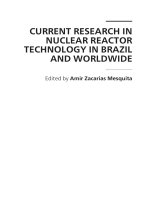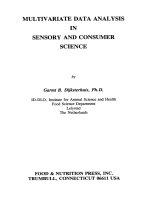Blockchain technology cognitive computing and heal
Bạn đang xem bản rút gọn của tài liệu. Xem và tải ngay bản đầy đủ của tài liệu tại đây (1.46 MB, 6 trang )
See discussions, stats, and author profiles for this publication at: />
Blockchain Technology, Cognitive Computing, and Healthcare Innovations
Article · January 2017
DOI: 10.12720/jait.8.3.194-198
CITATIONS
READS
0
137
5 authors, including:
Arman Sargolzaei
Saman Sargolzaei
Florida Polytechnic University
Florida International University
46 PUBLICATIONS 266 CITATIONS
29 PUBLICATIONS 165 CITATIONS
SEE PROFILE
SEE PROFILE
Some of the authors of this publication are also working on these related projects:
Active fault tolerant control design for nonlinear systems. View project
All content following this page was uploaded by Arman Sargolzaei on 01 November 2017.
The user has requested enhancement of the downloaded file.
Journal of Advances in Information Technology Vol. 8, No. 3, August 2017
Blockchain Technology, Cognitive Computing,
and Healthcare Innovations
Jeff Daniel1, Arman Sargolzaei2, Mohammed Abdelghani3, Saman Sargolzaei4,5, Ben Amaba6
1
Lockheed Martin, Dallas, TX, USA
Florida Polytechnic University, Lakeland, FL, USA
3
University of Alberta, Edmonton, AB, Canada
4
University of California Los Angeles, Los Angeles, CA, USA
5
Rancs Group LLC, Wilmington, DE, USA
6
IBM Corporations, Miami, FL, USA
Email:
2
Abstract— Exponential growth of the impact of information
technology innovation is an indispensable part of today’s
industry. Blockchain technology has identified itself as an
efficiency booster and service optimization for financial
industries. Yet non-financial venues have gained little
benefit from this new major horizon, Blockchain technology.
It offers a secure way to exchange any kind of good, service,
or transaction. Industrial growth increasingly depends on
trusted partnerships; but increasing regulation, cybercrime
and fraud are inhibiting expansion. Blockchain enables
more agile value chains, faster product innovations, closer
customer relationships, and faster integration with the
Internet of Things (IoT) and cloud technology. Now with
Cloud and Blockchain technologies providing high
computing power and network capabilities, cognitive
systems are available tools to deepen the relationship
between humans and the world. Many problems that have
been with our society for a long time can be solved.
Cognitive systems are the tools to accomplish that ambitious
goal. This study is continuing our effort on surveying the
applicability of Blockchain technology innovation in nonfinance (non-bitcoin). The study concluded with discussing
opportunities and challenges of the application of two intrahorizons of Blockchain technology, Cognitive Computing
and Healthcare.
Index Terms—blockchain technology, cognitive computing,
healthcare innovation, scalability, trust
I.
INTRODUCTION
Blockchain was firstly introduced as the computational
infrastructure of Bitcoin, a digital currency, but has
tremendously found much interest in a variety of
industrial application domains. Blockchain technology
owes major of this trend to its underlying trust system
without the requirement of central authority. Creation of
Smart contracts where each transaction is verifiable and
transparent, made the Blockchain technology to be named
as one of the emerging horizons of 2017 [1]. In 2008,
Satoshi Nakamoto introduced the world to Bitcoin by
releasing the paper, “Bitcoin: A Peer-to-Peer Electronic
Manuscript received May 1, 2017; revised August 1, 2017.
© 2017 J. Adv. Inf. Technol.
doi: 10.12720/jait.8.3.194-198
194
Cash System.”[2] The proposal was to distribute
electronic transactions rather than maintain dependency
on centralized institutions for the exchange. When
looking at Bitcoin the new concept is the Blockchain
framework based on research for time stamping packages
and protecting the chain of custody. Blockchain is
essentially a simplified payment verification system.
Blockchain keeps evolving in a number of industrial
domains as the body of research grows[3]. Researchers
are working to apply a number of use cases included
smart contracts, such as supply chain, and healthcare. The
scalability feature and distributed implementation of
Blockchain technology makes it a powerful tool to
improve the supply chain process where Ecopreneurs
were given the option to make informed decisions toward
improving global economy and sustainability of the
project where supply chain is implemented [4]. The flow
initiated from raw material to the final product until they
are handed to the end consumer could gain benefit from
this distributed implementation of scalable ledger
platform, Blockchain technology, to track the supply
chain elements, ranging from raw materials to the
transportation equipment to the human resources. Authors
predict the utility of Blockchain technology in the novel
supply chain managements could place companies in a
higher level of competition for enhanced socio-economic,
socio-environmental and eco-efficiency[4].
Released statistics by Centers for Disease Control
(CDC) prevention [5], [6] and the estimated projection of
chronic diseases prevalence in the next decade [7], are
evidences for the inefficiencies in current healthcare
networks. Reports revealed the existence of exponential
correlation between poor care coordination and
unnecessary cases of hospitalizations. These are all on a
side of extensive financial burden of unsatisfactory
treatments, according to Gallup organization survey via
patients. Current trend in healthcare services are more
inclined toward remote patient care, real-time long-term
health surveying plus sustained health monitoring with
multi-stages personalized treatment[8], [9]. Evolvement
of mobile technology in healthcare has shown to be a
two-edged sword. Increasing the number of applications
Journal of Advances in Information Technology Vol. 8, No. 3, August 2017
detect insurance fraud. [20] combined the logistics of
Blockchain with Radio Frequency Identification (RFID)
in the food network supply chain. The next two sections
discuss two landmarks where authors concluded them as
the intra-horizons of the Blockchain technology for the
next decade, Cognitive Computing and Healthcare.
and their potential to provide healthcare network
customers a quicker service along with facilitating the
communication line between healthcare provider and
healthcare payee (customer) were among the benefits of
mobile technology incorporation in healthcare network.
However, Following HIPAA (Health Insurance
Portability and Accountability Act of 1996) privacy rule,
individually identifiable health information including
demographic and genetic information, that is transmitted
or maintained in any form or medium, is categorized as
Protected Health Information (PHI)[10][11]. HIPAA
privacy rule created a set of standards on keeping the
privacy of the individuals’ PHI under security and gives
patient’s rights over those protected health information.
Although the rapid growth of cloud utilization for
creation of HIPAA-compliant database boosted the
physical safeguarding of information and reduced HIPAA
violations, however this mitigation to distributed
databases on the cloud would not alone solve the health
care payee and provider’s dilemma of privacy breaches.
This ultimate concern yields to applicability of novel
cryptographic technologies, such as the one enlisted for
Blockchain technology into the HIPPAA compliant
healthcare networks. Prior work of authors have
introduced an implementation of Blockchain powered
infrastructure, HealthChain, for the storing and retrieval
of protected health information in a secured, scalable and
cloud-friendly yet HIPPAA compliant fashion [9][8].
The current study is an effort to systematically surveys
the non-finance applications of BlockChain technology,
and specifically two very specific landmarks of
Blockchain technology, Blockchain and Cognitive
Computing; Blockchain and Healthcare, that have been
recently highlighted by industry pioneers.
II.
III.
Data has become the new currency transforming to
information, creating knowledge, and interpreted for
action through the lens of mathematical models and
embedded technologies. As a utility we have recognized
the importance of data analytics and potential of
cognitive computing, which is a revolutionary step
forward in the understanding of human machine
interaction. Data science competences are developed in
all areas, including customer retail sales, power plant
operation and maintenance as well as trading. The
business case is always a little different, however the data
science competences are similar in all these areas.
Data analytics development is in tremendous demand,
using experiments, POCs and pilots in multiple areas.
Based on these experimental activities we develop our
vision and direct all the activities towards this common
goal. At this point of time the experiments are running.
Many platforms and processes are tested. One of the IoT
platforms for the pilots is IBM’s Bluemix. We have
already run some pilots using Bluemix utilizing machine
learning and cognitive capabilities. The competitive edge
utilizing Bluemix with Watson cognitive computing
capabilities is the possibility to use unstructured data to
look for insight or patterns that may not be transparent.
Component failures can be predicted and the model can
be developed using supervised machine learning or
unsupervised machine learning. Cognitive computing is
not meant to replace human decision-making, but
compliment the process.
In 1946 IBM joined forces with Columbia University
to create the first academic program called “computer
science.” The event changed the world forever and
continues to influence us every day of our lives. We are
undergoing another major shift in how voice recognition,
tablets, smart phones, artificial intelligence, data analytics,
autonomous vehicles, robotics, cyber- security, social
media, cloud technology, etc. are coming together in a
new Cognitive Era, which will change the citizens’
quality of life, energy development, public service,
customer service, and enhance research capabilities.
Cognitive computing is a revolutionary step forward in
the understanding of human machine interaction.
Cognitive computing can be defined using two key
principles:
1. Computers facilitate or perform the process or
patterns humans define as thinking,
2. Enable the cooperation between computers and
humans to solve or accomplish a complex task, without
the existence of a predefined answer or program.
The idea of Cognitive computing didn't emerge
recently, and has been part of our culture for a long time.
For decades (maybe more) humans have dreamed of
BLOCKCHAIN ROADMAP
The focus of the current survey has been placed on
2015 and 2016 to cover the timeline when previous
surveys did not include and we limited our search to
IEEE Xplore search engine with the keyword of
“Blockchain”. A total of 65 IEEE indexed publications
were hit. Twenty-five percent of the results were ranked
as publications toward non-bitcoin applications of
Blockchain technology. Majority of Blockchain
applications were devoted to configuration, build and
implementation and control of Internet of Things (IoT)
devices [12]. Advancing the communication protocols to
the era of Internet of Things (IoT) has shown promising
improvements in smart cities and autonomous
transportation [13]. Decentralized trust creation and
scalability of Blockchain is being adjusted for the
connection of sensors and actuators in the IoT using
hybrid cloud platform by defining new business models
with improved security and access privileges based on
mapping the subscription request to the IoT as digital
currency exchanges among users of IoT [14][15][16][17].
An interesting application domain proposed by [18]
introduced Blockchain as an infrastructure for tracking
and identifying illegal digital footprints on Wi-Fi
hotspots. A similar scheme was proposed by [19] to
© 2017 J. Adv. Inf. Technol.
BLOCKCHAIN AND COGNITIVE COMPUTING
195
Journal of Advances in Information Technology Vol. 8, No. 3, August 2017
computers, which can simulate complex human reasoning
patterns. As technology evolved, we reached the point
where we are on the brink of computers being able to
accomplish complex tasks left in the past only for humans.
In February 2011 IBM introduced Watson, the first
widely seen demonstration of a cognitive system. IBM
Watson defeated Ken Jennings and Brad Rutter in
Jeopardy! a game largely believed to require human
cognition.
data
sharing
have
patients
scientific
bitcoin
intelligence
market increasing
can research
technologyincluding
medrec
with
release
secure
party
their
new
system
own
perspective
healthcare
from
decentralized
while
this
management
focus switching
trusted
generation
mobile nodes
novel smart
without
public
trials
policy
these
are
medical
based
was
the
health
patient
privacy
which
other
mining
use possible our
here has
industry proposed been psn
systems
than many risks
pervasive cloud more future
trial were one provides
genome control
over
share
its
social
horizon enable security
work study
service
paper third
protocols
challenges
access
for
how
show
network
that
globalmodel where
computing
researchers
using
protocol
conservation
clinical
improve
applications
provide
hardware
some
providers
first emerging
method
IV.
A graphical summary of text analytics on the survey
results.
When Watson played Jeopardy! it focused primarily on
one NLP task: Question answering. Since then, IBM has
developed an ecosystem of cognitive capabilities
available in Bluemix that can enable companies to create
truly cognitive solutions. Cognitive computing is not a
single discipline of Computer Science - it is a
combination of multiple fields, including Natural
Language Processing and Artificial Intelligence, and
more importantly, using industry expertise in the creation
of solutions where humans and computers collaborate
constantly to obtain the best outcome. There are five core
capabilities of Cognitive systems:
1. They create a deeper human engagement, as they try
to understand the human qualities of the user that
interacts with them, delivering an overall greater value
2. They scale and elevate the expertise, as they can
automatically ingest huge volumes of documents in
context, and help the experts and professionals navigate
vast amounts of information available to them
3. They infuse products and services with cognition,
allowing products and services to sense and to improve
themselves using adaptation
4. They enable cognitive processes and operations,
which allow businesses to heightened awareness of
workflows, context and environment
5. They enhance exploration and discovery, as they
allow increasingly uncovering complex patterns and
opportunities.
© 2017 J. Adv. Inf. Technol.
BLOCKCHAIN AND HEALTHCARE INNOVATION
Following a survey of two peer-reviewed scientific
indexing websites, PubMed (www.ncbi.nlm.nih.gov) and
IEEEXplore (www.ieeexplore.ieee.org). “Blockchain”
and “Blockchain Healthcare” were the search terms for
PubMed and IEEEXplore, respectively. A total of 10
publications (2 conference and 8 journal publications)
were relevantly found to the subject. Fig. 1 shows a
summary of word analytics on these search results.
As the figure presents, Blockchain technology is an
umbrella for a network of decentralized nodes where
objective has been to enhance privacy, security,
trustworthy and transparency. [21] discusses a few
avenues where the Blockchain technology applicability
could be assessed for healthcare sector. Three application
domains were discussed in [22][23], [24] where
modularity feature of Blockchain infrastructure joins
mobile computing implemented on Pervasive Social
Network (PSN)-based network could enhance the
wireless transfer and organizations of medical records.
[25] shed light into a very important issue of clinical trail
data. According to [25], more than half of the clinical
trials lack the availability of all corresponding methods
and results. Suggested protocol in the hands of
Blockchain smart contract with its attached trust and
transparency could be where the level of medical service
can be significantly improved. [26] surveyed Blockchain
to a broader range of application and theory for the time
range of 2013-15 where they reported more than 80% of
the efforts in Blockchain have been allocated to the
Bitcoin. A modified Blockchain protocol using timestamping was empirically shown [27] to be a low cost
and secured replacement for the existing audit process of
clinical studies.
Although the survey agreed with our initial hypothesis
of underestimating the applicability of Blockchain
technology in healthcare compared with other industrial
sectors, However, implementation of Blockchain
contracts
science
issues
such potential solutions
blockchain
Figure 1.
Our understanding of Cognitive computing today is
heavily influenced for the societal and business need in
our communities. All technology revolutions are
propelled by our need for better technologies. Cars that
drive themselves, cities that take into account your
emotions and interact with their citizens accordingly,
systems that guide emergency respondents and give them
accurate summaries of all information crossing across
multiple agencies, and products that continually improve
their performance through sensing and monitoring use
IoT (Internet of Things). For a long time, creating truly
cognitive systems was beyond the reach of our
technology. Today, we are in the brink of the
generalization of Cognitive systems in all markets, and
the general availability of intelligent machines that work
side by side with humans in all tasks.
We believe Cognitive systems are tools to deepen the
relationship between humans and the world. Many
problems that have been with our society for a long time
can be solved, and Cognitive systems are the tools to
accomplish that ambitious goal.
196
Journal of Advances in Information Technology Vol. 8, No. 3, August 2017
technology in healthcare may not be as straightforward
solution as is for other industrial applications for the very
clear reason of Protected Health Information (PHI) being
traded as a digital currency. Following HIPAA (Health
Insurance Portability and Accountability Act of 1996) [10]
privacy rule, individually identifiable health information
including demographic and genetic information, that is
transmitted or maintained in any form or medium, is
categorized as Protected Health Information (PHI) [11].
Authors have pioneered in suggesting a framework,
HealthChain [9], for how Blockchain powered
technology could improve the healthcare while increasing
the level of security embedded inside the healthcare
network.
REFERENCES
[1]
[2]
[3]
[4]
[5]
[6]
[7]
[8]
[9]
[10]
[11]
[12]
[13]
[14]
[15]
[16]
[17]
[18]
W. J. Sutherland et al., “A 2017 horizon scan of emerging issues
for global conservation and biological diversity,” Trends Ecol.
Evol., vol. 32, no. 1, pp. 31–40, Jan. 2017.
S. Nakamoto. (2008). Bitcoin: A peer-to-peer electronic cash
system. [Online]. Available: www.bitcoin.org, p. 9.
M. Pilkington, Blockchain Technology: Principles and
Applications.
S. Noei, A. Sargolzaei, K. Yen, S. Sargolzaei, and N. Wu,
“Ecopreneur selection using fuzzy similarity TOPSIS variants,”
“Chronic Disease Prevention and Health Promotion | CDC.”
[Online]. Available: />T. findings, conclusions in this report are those of the authors, and
do not necessarily represent the official position of the Centers for
Disease Control, “PCD Collection: Multiple Chronic Conditions.”
H. W. S. Mattke, L. Klautzer, T. Mengistu, J. Garnett, and J. H.
Hu, “Health and well-being in the HOMEA global analysis of
needs, expectations, and priorities for home health care
technology,” 2010.
S. Sargolzaei, B. Amaba, M. Abdelghani, and A. Sargolzaei,
“Cloud-based smart health-care platform to tackle chronic
disease,” vol. 4863, no. August, pp. 30–32, 2016.
T. Ahram, A. Sargolzaei, S. Sargolzaei, J. Daniels, and B. Amaba,
“Blockchain Technology Innovations,” in Proc. 2017 IEEE
Technology and Engineering Management Society Annual Conf,
2017, p. TBD.
U. S. D. H. and H. Services, “Standards for privacy of individually
identifiable health information; proposed rule,” Fed. Regist., vol.
64, no. 212, p. 59917, 1999.
Centers for Medicare and Medicaid Services, “Security standards:
Technical safeguards,” HIPAA Secur. Ser., vol. 2, pp. 1–17, 2007.
S. Huh, S. Cho, and S. Kim, “Managing IoT devices using
blockchain platform,” in Proc. 2017 19th International
Conference on Advanced Communication Technology (ICACT).
pp. 464–467, 2017.
S. Noei, A. Sargolzaei, A. Abbaspour, and K. Yen, “A decision
support system for improving resiliency of cooperative adaptive
cruise control systems,” Procedia Comput. Sci., vol. 95, pp. 489–
496, 2016.
S. H. Hashemi, F. Faghri, P. Rausch, and R. H. Campbell, “World
of empowered IoT users,” in Proc. 2016 IEEE First International
Conference on Internet-of-Things Design and Implementation
(IoTDI). pp. 13–24, 2016.
S. Huh et al., Might the Blockchain Outlive Bitcoin?, vol. 18, no. 2.
MIT Press, 2016, p. 256.
K. Christidis and M. Devetsikiotis, “Blockchains and smart
contracts for the internet of things,” IEEE Access, vol. 4. pp.
2292–2303, 2016.
Y. Zhang and J. Wen, “An IoT electric business model based on
the protocol of bitcoin,” in Proc. 2015 18th International
Conference on Intelligence in Next Generation Networks, 2015, pp.
184–191.
T. Sanda and H. Inaba, “Proposal of new authentication method in
Wi-Fi access using Bitcoin 2.0,” in Proc. 2016 IEEE 5th Global
Conference on Consumer Electronics, 2016, pp. 1–5.
© 2017 J. Adv. Inf. Technol.
197
[19] I. Nath, “Data exchange platform to fight insurance fraud on
blockchain,” in Proc. 2016 IEEE 16th International Conference
on Data Mining Workshops, 2016, pp. 821–825.
[20] F. Tian, “An agri-food supply chain traceability system for China
based on RFID & blockchain technology,” in Proc. 2016 13th
International Conference on Service Systems and Service
Management (ICSSSM), 2016, pp. 1–6.
[21] M. Mettler, “Blockchain technology in healthcare: The revolution
starts here,” in Proc. 2016 IEEE 18th International Conference on
e-Health Networking, Applications and Services (Healthcom),
2016, pp. 1–3.
[22] J. Zhang, N. Xue, and X. Huang, “A secure system for pervasive
social network-based healthcare,” IEEE Access, vol. 4, pp. 9239–
9250, 2016.
[23] A. Ekblaw, A. Azaria, J. D. Halamka, A. Lippman, I. Original,
and T. Vieira, “A case study for blockchain in healthcare:
‘ MedRec ’ prototype for electronic health records and medical
research data MedRec: Using Blockchain for Medical Data Access
and Permission Management,” 2016.
[24] A. Azaria, A. Ekblaw, T. Vieira, and A. Lippman, “MedRec:
Using blockchain for medical data access and permission
management,” in Proc. 2016 2nd International Conference on
Open and Big Data (OBD), 2016, pp. 25–30.
[25] T. Nugent, D. Upton, and M. Cimpoesu, “Improving data
transparency in clinical trials using blockchain smart contracts,”
F1000Research, vol. 5, p. 2541, Oct. 2016.
[26] J. Yli-Huumo, D. Ko, S. Choi, S. Park, and K. Smolander, “Where
is current research on blockchain technology?—A systematic
review,” PLoS One, vol. 11, no. 10, p. e0163477, Oct. 2016.
[27] G. Irving and J. Holden, “How blockchain-timestamped protocols
could improve the trustworthiness of medical science,”
F1000Research, vol. 5, p. 222, May 2016.
Jeff Daniels received his Ph.D. in Technology Management and Digital
Communications from Indiana State University, a Master’s degree in
Management of Technology from Rensselaer Polytechnic Institute, and
a B.S. degree from the University of Central Florida. Dr. Jeff Daniels is
the senior manager of applications services, integration, and strategy at
Lockheed Martin Corporation, a global security company that employs
about 98,000 people worldwide. He is a recognized Chief Information
Security Officer, principally engaged in the research, design,
development, manufacture, integration and sustainment of advanced
technology systems, products and services with sales of over $46.1
billion.
Arman Sargolzaei received his M.Sc. and Ph.D. degrees in Electrical
and Computer Engineering from Florida International University,
Miami, FL, USA in 2012 and 2015, respectively. He is currently a
faculty member with the Electrical Engineering department at Florida
Polytechnic University. His research interests include control and power
systems, telecommunications, and security of networked control
systems and nonlinear systems.
Mohamed N. Abdelghani received Master’s degree in Electrical and
Computer Engineering from Southern Illinois University, and the first
Ph.D. degree in Neuroscience from the University of Toronto. He
received his second Ph.D. degree with the department of Mathematics
and Statistics, University of Alberta. His research interests include
stochastic control, sensory motoro control, and neural information
processing.
Saman Sargolzaei received B.Sc. and M.Sc. degree in Electrical
Engineering from University of Mazandaran and Amirkabir University
of Technology (Tehran Polytechnic) in 2006 and 2009 back home. He
then received his second M.Sc. degree in Electrical Engineering
from University of Miami, Miami, USA, in 2012 and his Ph.D. in
Electrical Engineering from Florida International University, Miami,
USA, in 2015. He is largely involved in national and international fundraising events for raising awareness in health and medicine. Dr. Saman
Sargolzaei’s expertise is in applying machine learning and artificial
intelligence to the field of medicine and biology
Journal of Advances in Information Technology Vol. 8, No. 3, August 2017
Ben Amaba holds a PhD. degree in Industrial & Systems Engineering;
a M.B.A./M.S. degree in Engineering and Operations, and a B.S. degree
in Electrical Engineering. Dr. Amaba is a registered and licensed
Professional Engineer in several states with International Registry;
certified in Production, Operations, and Inventory Management by
APICS ®; LEED® Accredited Professional (Leadership in Energy &
Environmental Design); and certified in Corporate Strategy by
Massachusetts Institute of Technology in Cambridge, Massachusetts. Dr.
Amaba holds a copyright for Process Activity Flow Framework®, the
foundation for IBM’s Business Driven Development framework for
requirements, design, architecture, simulation, and application
© 2017 J. Adv. Inf. Technol.
View publication stats
198
development techniques. Dr. Amaba is prominently featured in “Giving
2.0,” by Laura Arrillaga-Andreessen with Stanford Business School,
which details contributions to bolster and promote STEM education and
careers, and is an Alexis de Tocqueville Society/United Way Member,
which recognizes local philanthropic leaders. Dr. Amaba has published
globally on best practices and robust approaches to drive market
innovation, economic development and private public partnerships. He
is responsible for health care, manufacturing, energy, petroleum,
chemical, nuclear, and logistics industries as the IBM Global executive
for the Hybrid Cloud Products Division.









